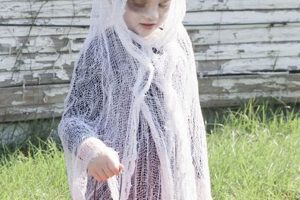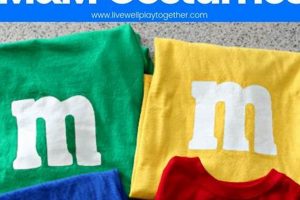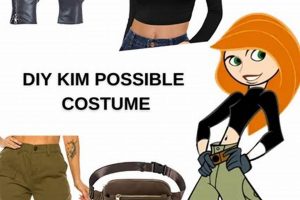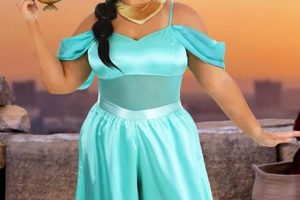The creation of a Maleficent-inspired ensemble, crafted at home through do-it-yourself methods, involves the independent design and assembly of clothing, accessories, and makeup to emulate the iconic Disney villain. This process typically includes fashioning the character’s distinctive horned headpiece, constructing a flowing black gown, and applying dramatic makeup to achieve the character’s signature look. For example, individuals might use craft foam to build the horns, repurpose fabric for the garment, and utilize contouring techniques to accentuate cheekbones.
Engaging in such projects offers numerous advantages. It provides a cost-effective alternative to purchasing commercially produced attire, allowing for customization and personalization to suit individual preferences and body types. Furthermore, it fosters creativity, problem-solving skills, and a sense of accomplishment. Historically, crafting one’s own apparel has been a common practice, representing resourcefulness and self-expression. This tradition continues to evolve as individuals adapt iconic characters into personalized works of art.
Subsequent sections will delve into specific techniques for creating various components of this character-inspired attire. Detailed instructions will be provided on crafting the horns, designing the gown, and mastering the makeup application. Additionally, material selection and cost-saving strategies will be addressed to facilitate successful and budget-friendly project completion.
Tips for a Successful Maleficent-Inspired Ensemble Creation
The following guidelines are designed to optimize the outcome when independently constructing a Maleficent-inspired ensemble. These tips address critical aspects of the creation process, ranging from material selection to construction techniques, to ensure a visually accurate and structurally sound result.
Tip 1: Accurate Horn Construction: Employ durable yet lightweight materials such as EVA foam or Worbla for the horns. Secure a robust internal structure, utilizing wire or sturdy craft foam, to maintain the horn’s shape throughout wear. Prioritize precise shaping and symmetrical design to authentically replicate the character’s iconic headwear.
Tip 2: Fabric Selection for Drape and Detail: Opt for fabrics like velvet, crepe, or heavy satin for the gown’s main body. These materials offer a suitable drape and visual depth, enhancing the garment’s overall aesthetic. Incorporate textured fabrics or strategically placed embellishments to capture the intricate details present in the character’s attire.
Tip 3: Mastering the Makeup Application: Achieve the character’s striking facial features through strategic contouring and highlighting. Utilize high-pigment eyeshadows in shades of purple, green, and black to create a dramatic, angular look. Ensure precise eyeliner application and consider using false eyelashes to enhance the character’s intense gaze.
Tip 4: Pattern Adaptation and Modification: When utilizing existing patterns, carefully adapt them to reflect the specific design elements of the character’s costume. Modify sleeve shapes, adjust neckline depths, and incorporate unique design lines to ensure accurate representation.
Tip 5: Prioritize Secure Fastenings and Closures: Employ robust closures such as heavy-duty zippers, hook-and-eye closures, or sturdy snaps to ensure the garment remains securely fastened during wear. Reinforce stress points with additional stitching to prevent tearing or breakage.
Tip 6: Attention to Detail in Accessories: Create or source accessories, such as the staff or rings, that accurately reflect the character’s signature items. Pay meticulous attention to the scale, texture, and color of these elements to enhance the overall authenticity of the ensemble.
Tip 7: Conduct a Fit Test and Make Necessary Adjustments: Prior to final assembly, perform a thorough fit test to identify any areas requiring adjustment. Modify the pattern or garment construction to achieve a comfortable and flattering fit. Account for movement and flexibility to ensure ease of wear.
By adhering to these guidelines, creators can significantly increase the likelihood of achieving a visually compelling and structurally sound recreation of the character’s iconic attire. The emphasis on accurate materials, construction techniques, and attention to detail contributes to a more authentic and impressive final result.
The subsequent sections will present detailed instructions on specific elements of this character-inspired creation, providing the necessary guidance to successfully complete this ambitious project.
1. Horn Construction
Horn construction constitutes a critical element within any attempt at creating a Maleficent-inspired ensemble through do-it-yourself methods. The distinct horns are arguably the most recognizable feature of the character, thus their successful replication is paramount to achieving a visually convincing likeness. Inadequate horn construction can diminish the overall impact of the entire endeavor, regardless of the quality of the remaining components. Examples of poor construction include horns that are misshapen, disproportionate, structurally unstable, or attached insecurely. Such flaws detract significantly from the desired aesthetic.
The cause-and-effect relationship is direct: skilled horn construction leads to a more authentic and recognizable representation of the character, while poor execution undermines the entire effort. The materials used, the chosen construction method (e.g., foam sculpting, 3D printing), and the attachment technique all influence the final result. For instance, selecting lightweight materials prevents the horns from being excessively heavy and uncomfortable. A secure attachment mechanism prevents the horns from detaching during wear, preserving the integrity of the ensemble. Proper shaping ensures the horns accurately reflect the character’s silhouette.
The understanding of this connection holds practical significance for those undertaking such projects. By prioritizing careful planning, material selection, and precise execution in horn construction, individuals can significantly enhance the realism and impact of the complete Maleficent-inspired ensemble. While other aspects, such as the gown and makeup, contribute to the overall effect, the horns serve as a focal point, demanding particular attention. Addressing the inherent challenges in recreating this complex form through a do-it-yourself approach ultimately improves the outcome of the project.
2. Gown Design
Gown design constitutes a significant element in the independent creation of a Maleficent-inspired ensemble. The garment serves as the primary visual component after the horns, influencing the overall aesthetic and recognizability of the character representation. Therefore, thoughtful design and execution are critical.
- Fa
bric Selection and DrapeThe choice of fabric directly impacts the gown’s visual appearance and how it hangs on the wearer. Fabrics like velvet, heavy satin, or crepe offer suitable drape and a luxurious look befitting the character. Lighter fabrics may lack the necessary structure and visual weight, detracting from the desired effect. For “costume maleficent diy,” budget constraints may lead to compromise, but understanding the impact of fabric choice remains essential.
- Silhouette and Construction
The silhouette should closely resemble the character’s gown, typically featuring a long, flowing design with wide sleeves or cape-like extensions. Construction techniques, such as incorporating gores or panels, contribute to the gown’s shape and movement. For instance, a poorly constructed bodice can compromise the fit and overall aesthetic, regardless of the fabric quality, affecting the accuracy of the independently crafted ensemble.
- Color Palette and Detailing
While primarily black, the gown may incorporate subtle variations in color and texture to add visual interest. Detailing, such as strategically placed embellishments, embroidery, or textured fabrics, can enhance the overall authenticity. Too little detail may result in a plain and uninspired garment, while excessive embellishment can appear gaudy or inaccurate. Maintaining balance in the independently crafted gown is key.
- Adaptation and Personalization
Individuals may choose to adapt the gown design to suit personal preferences or body types. This may involve modifying the neckline, sleeve shape, or overall length. While personalization is encouraged, maintaining the core visual elements of the character’s gown is essential for recognizability. In “costume maleficent diy,” individuals should aim to create a unique interpretation while staying true to the source material.
These facets of gown design are interconnected and contribute to the overall success of a Maleficent-inspired ensemble created independently. Consideration of fabric, silhouette, detailing, and adaptation allows individuals to achieve a visually compelling and recognizable representation of the character. The garment is a central element in conveying the desired aesthetic, highlighting the importance of careful planning and execution in any independent creation project.
3. Makeup Artistry
Makeup artistry plays a pivotal role in the successful realization of a Maleficent-inspired ensemble through do-it-yourself endeavors. The application of cosmetics transcends mere facial enhancement; it functions as a transformative element that completes the character’s persona, directly influencing the overall impact of the self-made attire.
- Contouring and Shadowing
Contouring and shadowing are crucial techniques for sculpting the face, mimicking the character’s sharp, angular features. Strategic application of darker shades beneath the cheekbones, along the jawline, and on the temples creates the illusion of enhanced bone structure. Inaccurate contouring can result in a softened, less defined face, diminishing the overall resemblance within the context of a self-made Maleficent attire.
- Eye Enhancement and Definition
Emphasis on the eyes is paramount, typically involving the use of deep, saturated eyeshadows in shades of purple, green, and black. Precise eyeliner application, extending beyond the natural lash line, further accentuates the eyes, creating a dramatic, piercing gaze. The use of false eyelashes can amplify this effect. Neglecting these details can result in a less intense, less recognizable portrayal, impacting the visual impact of the self-assembled costume.
- Lip Definition and Color
The lips are typically defined with a dark, matte lipstick, often in shades of deep red or burgundy. Precise application is essential to create a sharp, defined lip line. Imperfect lip definition can disrupt the character’s aesthetic, detracting from the overall accuracy of the independently constructed portrayal. Alternatively, some interpretations favor a more muted, almost absent lip, requiring a different set of makeup techniques.
- Skin Tone and Complexion
Achieving a pale, almost ethereal complexion often involves the use of foundation and powder that are several shades lighter than the individual’s natural skin tone. This creates a stark contrast against the dark eye makeup and lip color, further emphasizing the character’s otherworldly appearance. However, excessive or uneven application can lead to an unnatural, mask-like effect, negatively affecting the credibility of the do-it-yourself costume.
Collectively, these facets of makeup artistry directly influence the efficacy of a Maleficent-inspired creation. The successful execution of contouring, eye enhancement, lip definition, and complexion manipulation results in a more convincing and visually striking representation of the character. In contrast, shortcomings in any of these areas can diminish the overall impact of the independently crafted ensemble, underscoring the importance of meticulous attention to detail and skillful application techniques.
4. Accessory Selection
Accessory selection represents a crucial phase within the domain of independently crafting a Maleficent-inspired ensemble. These complementary items, while not constituting the primary attire, significantly augment the visual impact and authenticity of the final presentation. Therefore, judicious selection and meticulous execution of these components contribute substantively to the overall success of the self-made costume.
- The Staff
The staff serves as a signature accessory, immediately recognizable and integral to the character’s silhouette. Its design typically incorporates a gnarled branch, often topped with a glowing orb or raven figure. The materials employed in its construction, such as wood, resin, or craft foam, impact its durability and visual appeal. A poorly constructed or disproportionate staff diminishes the overall authenticity of the “costume maleficent diy” project, whereas a well-crafted staff enhances the impression.
- Rings and Jewelry
The character often adorns rings, typically featuring dark stones or intricate designs. These additions, though smaller in scale, contribute to the overall aesthetic by reinforcing the character’s malevolent elegance. The selection of rings should align with the color palette and stylistic elements of the attire. Inappropriate jewelry can clash with the rest of the ensemble, undermining the visual coherence of the independently created portrayal.
- Headwear Embellishments
Variations in the horns or supplemental headwear features can further differentiate the Maleficent-inspired look. These may include decorative elements at the base of the horns or subtle enhancements to the overall headpiece. Such additions require careful consideration to avoid detracting from the primary visual focus, which remains the horns themselves. Overly elaborate or incongruous embellishments disrupt the harmony of the “costume maleficent diy” presentation.
- Footwear
While often less visually prominent, the choice of footwear plays a role in completing the overall look.
Typically, dark boots or shoes are selected to complement the gown. The style of footwear should align with the overall aesthetic, avoiding overly modern or incongruous designs. Selecting appropriate footwear reinforces the intended character portrayal, while ill-suited shoes detract from the visual cohesion of the self-made ensemble.
These individual facets of accessory selection collectively influence the efficacy of a Maleficent-inspired ensemble created through do-it-yourself methods. The successful integration of the staff, rings, headwear enhancements, and footwear results in a more comprehensive and convincing portrayal of the character. Therefore, careful attention to these details is warranted when undertaking such independent creation projects, as these seemingly minor elements contribute significantly to the overall impact.
5. Pattern Modification
Pattern modification is a fundamental aspect of creating a Maleficent-inspired ensemble through do-it-yourself methods. Rarely will pre-existing patterns perfectly match the specific design elements of the character’s distinctive gown. Modification is therefore essential to achieving a visually accurate and recognizable representation. The absence of pattern modification results in a garment that deviates from the intended design, potentially compromising the overall effect of the “costume maleficent diy” project. A basic A-line dress pattern, for example, will necessitate significant alterations to incorporate the flowing sleeves, dramatic collar, and unique bodice shaping characteristic of the character’s attire.
The process involves adapting existing patterns or drafting new pattern pieces to reflect the specific design lines, volume, and details of the desired costume. This may include altering sleeve shapes, adjusting neckline depths, adding or removing fullness in skirts, and creating unique design lines on the bodice. For instance, replicating the characters high, pointed collar requires drafting a custom pattern piece and integrating it seamlessly into the bodice construction. Similarly, achieving the characteristic flared sleeves might involve adding width to a standard sleeve pattern and adjusting the shaping for a dramatic effect. Skilled pattern modification ensures that the resulting garment accurately reflects the proportions and design elements of the character’s iconic look. Failure to properly modify a pattern can lead to a garment that lacks the intended visual impact and overall authenticity of the project.
In summary, pattern modification is not merely an optional step but a critical component of successful “costume maleficent diy.” It is the mechanism through which generic patterns are transformed into accurate representations of the character’s unique design. Mastery of this skill elevates the quality of the final product, enabling creators to achieve a visually compelling and recognizable ensemble. While challenges may arise in adapting complex design elements, the ability to modify patterns effectively is paramount to the success of any independently created, character-inspired attire, especially for complex designs such as a Maleficent costume.
6. Material Cost
Material cost is a significant determinant in the feasibility and scope of a Maleficent-inspired ensemble created through do-it-yourself methods. The financial investment required for fabrics, embellishments, and construction materials directly influences the final quality, complexity, and overall aesthetic of the project. A higher budget allows for the utilization of premium materials, intricate detailing, and specialized tools, leading to a more accurate and visually impressive representation of the character. Conversely, budgetary constraints necessitate compromises in material selection, potentially impacting the final outcome. For example, opting for inexpensive synthetic fabrics instead of higher-quality velvet reduces the overall cost but can also diminish the luxurious appearance characteristic of the character’s attire.
The relationship between material cost and the final product is a direct cause-and-effect scenario. Inexpensive materials often correlate with reduced durability, less accurate color representation, and a diminished overall aesthetic appeal. Conversely, investing in higher-quality fabrics and embellishments enhances the visual fidelity and longevity of the costume. Real-life examples demonstrate this principle; a costume constructed with repurposed materials and thrift store finds may be economically advantageous but could lack the visual impact of a costume made with carefully selected, high-end fabrics. The practicality of understanding this connection lies in the ability to strategically allocate resources, balancing cost considerations with desired aesthetic outcomes. Cost-saving strategies can involve sourcing materials during sales, utilizing coupons, or creatively repurposing existing fabrics, but it is important to acknowledge the potential impact on the final result.
In conclusion, material cost represents a primary constraint and a critical decision-making factor within independently creating a Maleficent inspired costume. Balancing budgetary limitations with the desired aesthetic outcome requires careful planning, resourcefulness, and a realistic understanding of the trade-offs involved. While cost-effective solutions are often necessary, recognizing the direct correlation between material quality and the final product enables creators to make informed decisions that maximize visual impact within their financial means, but compromise on quality may be detrimental to the overall impact of the final costume.
7. Comfort, Durability
The interplay between comfort and durability is a paramount consideration in the realm of “costume maleficent diy.” While aesthetic accuracy is a primary objective, a garment that is uncomfortable or prone to damage detracts significantly from the overall experience. The character’s attire, often elaborate and potentially restrictive, necessitates careful planning to ensure wearability over extended periods. Ignoring comfort and durability factors can lead to a costume that is visually impressive but impractical, rendering it unsuitable for conventions, performances, or other events where prolonged wear is required. For example, a gown constructed from heavy, non-breathable fabric, while visually accurate, becomes unbearable after a short period, diminishing the wearer’s enjoyment and potentially leading to overheating.
Durability is also crucial, affecting the longevity and reusability of the self-made costume. A gown constructed with weak seams or delicate materials is susceptible to tearing or damage, particularly during active use. Such vulnerabilities necessitate constant vigilance and repair, detracting from the wearer’s experience. Conversely, a costume constructed with reinforced seams, durable fabrics, and robust closures can withstand the rigors of repeated wear, ensuring its longevity and providing greater value for the investment of time and resources. Examples include reinforcing the horn attachment to prevent breakage and lining the gown to prevent tearing during movement. Balancing the desire for visual accuracy with the need for practicality represents a key challenge
in “costume maleficent diy.”
In summary, comfort and durability are not secondary considerations but integral components of a successful “costume maleficent diy” project. Prioritizing these factors alongside aesthetic accuracy ensures that the resulting ensemble is not only visually impressive but also functional and long-lasting. Careful selection of materials, thoughtful construction techniques, and proactive reinforcement are essential for achieving this balance. Neglecting these aspects undermines the overall value and practicality of the independently created attire. A comfortable and durable costume allows the wearer to embody the character fully, enhancing the overall experience and maximizing the return on investment.
Frequently Asked Questions
The following section addresses frequently encountered inquiries and misconceptions regarding the creation of a Maleficent-inspired ensemble through do-it-yourself methods. The intent is to provide concise, authoritative answers to common concerns.
Question 1: What are the most common pitfalls encountered during horn construction, and how can they be avoided?
Instability and asymmetry are prevalent issues. Employing a robust internal support structure, such as wire armature or rigid foam, mitigates instability. Careful measurement and pattern mirroring ensure symmetry.
Question 2: How does fabric selection impact the overall visual quality of a Maleficent gown, and what fabrics are most suitable?
Fabric choice significantly affects drape, texture, and perceived luxury. Velvet, crepe, and heavy satin offer appropriate drape and visual depth. Lightweight or inexpensive synthetics often lack the necessary visual weight.
Question 3: What makeup techniques are essential for achieving an accurate Maleficent-inspired look, and which are frequently overlooked?
Strategic contouring, dramatic eye enhancement, and precise lip definition are critical. Often overlooked is the importance of a pale complexion, achieved through careful foundation and powder application.
Question 4: How can pattern modification enhance the authenticity of a self-made Maleficent gown, and what are some common adaptation strategies?
Pattern modification allows for accurate replication of the character’s unique design elements. Common adaptations include adjusting sleeve shapes, altering neckline depths, and adding volume to skirts.
Question 5: What are effective strategies for minimizing material costs while maintaining acceptable quality in a “costume maleficent diy” project?
Strategic sourcing during sales, utilizing coupons, and creatively repurposing existing materials can reduce costs. However, recognize that compromising on material quality may impact the final aesthetic.
Question 6: How can comfort and durability be effectively integrated into the design and construction of a self-made Maleficent ensemble?
Selecting breathable fabrics, reinforcing seams, and incorporating comfortable closures are essential. Prioritize ease of movement and consider lining the garment to prevent chafing.
The key takeaways are that careful planning, strategic resource allocation, and attention to detail are crucial for success. Each element, from horn construction to makeup application, contributes to the overall impact of the “costume maleficent diy” project.
Subsequent sections will delve into advanced techniques for enhancing the realism and impact of specific costume components.
Conclusion
The preceding exploration of “costume maleficent diy” has illuminated the multifaceted considerations involved in independently crafting a Maleficent-inspired ensemble. Key points include the critical importance of accurate horn construction, the strategic selection of fabrics for optimal drape, the skillful application of makeup techniques to capture the character’s distinctive features, and the nuanced art of pattern modification to replicate the gown’s unique design. Furthermore, the delicate balance between material cost, comfort, and durability has been emphasized as essential to achieving a visually compelling and practically wearable result. The undertaking requires meticulous planning, technical proficiency, and a commitment to detail.
The act of independently constructing such an elaborate piece transcends mere costume creation; it represents a tangible embodiment of artistry, resourcefulness, and dedication. As individuals embark on this endeavor, they are encouraged to embrace the challenges, leverage the provided insights, and strive for a final product that reflects not only the character’s iconic image but also the creator’s unique vision and skill. The creation is not just for show, it is the experience and art that one gain with it.







